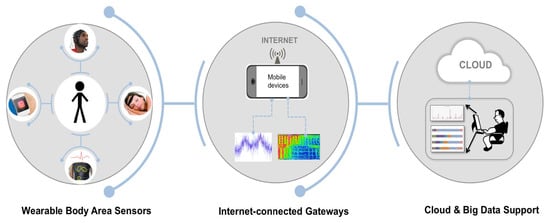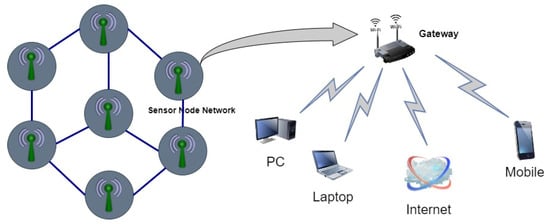You're using an outdated browser. Please upgrade to a modern browser for the best experience.
Please note this is a comparison between Version 1 by Waheb A. Jabbar and Version 2 by Conner Chen.
The Internet of Wearable Things (IoWT) aims to improve people’s quality of daily life. It involves sensors fitted into wearable devices, monitoring the individual’s activity, health factors, and other things.
- IoT
- IoWT
- healthcare
1. Internet of Wearable Things
The Internet of Wearable Things (IoWT) aims to improve people’s quality of daily life. It involves sensors fitted into wearable devices, monitoring the individual’s activity, health factors, and other things. The data collected from the IoWT can be fed into medical infrastructure, giving clinicians remote access to their patients’ data as they go about their daily lives. Building on the internet of things (IoT) architecture, a novel integrative framework for IoWT is currently being developed. The IoWT is a revolutionary technology that has the potential to change the healthcare industry by creating an ecosystem for automated telehealth treatments [1][41].
As shown in Figure 12, the architecture of the IoWT and its connections consists of three elements: the WBAN, the gateway connected to the Internet, and the cloud. The WBAN is a front-end component of IoWT that wraps around the body to collect health-related data unnoticed. The WBAN collects data from sensors in direct contact with the body or from sensors in the environment that can collect indirect data about a person’s behavior. The WBAN can either analyze the data or transmit them for remote analysis. In addition, mobile computing devices such as smartphones, tablets, and laptops must be connected to the Internet to send data to powerful computing resources [2][42].
2. Wireless Network Technologies for IoT Healthcare
Healthcare systems can be monitored remotely using various wireless network technologies. The existence and operation of IoT emerging technologies, such as RFID, wireless network technologies (BLE, Wi-Fi, Zigbee), and low-power wireless area network (LPWAN) technologies (such as LoRa and SigFox) are engaging in terms of the IoT’s long-term development and deployment. They enhance device connectivity to the Internet, and the efficiency of IoT application operation [3][43].
BLE, LoRa, and Zigbee are wireless sensor network technologies; meanwhile, to identify and trace products, RFID is used. BLE can transfer data between different mobile devices [4][44]. Communication methods can be long in their range (LoRa, SigFox, and Wi-Fi) or short-range (Bluetooth, RFID, and Zigbee) [5][24]. Due to new communication protocols being created exclusively for IoT devices, such as LoraWAN, NB-IoT, and Sigfox, it is anticipated that the popularity of these applications will increase, enabling a far-reaching remote monitoring system [6][7][11,45].
An essential component of the IoT is the WSN. The IoT, which has already been established, can connect things to the Internet, allowing humans to interact with computers and for computers to interact with other computers. Thus, the combination of the IoT and WSN facilitates machine-to-machine communication. Figure 23 illustrates the architecture of IoT with the WSN. It shows sensor nodes communicating with a gateway in a separate network. Many devices are linked to the gateway via Wi-Fi or the Internet, ensuring interoperability [8][46].
The researchers in [5][24] counted the existing wireless applications in connected healthcare facilities to study operational wireless methods for transmitting data across short distances. The system design and implementation of family mobile medical care are presented in this study. The Android mobile client, data transmission, and a system server are part of the system. Wireless data transfer is potentially possible, at least in theory. An example of the mobile healthcare system’s success is shown here. In the first place, family members’ sign characteristics might be collected via sensors on medical equipment. electrocardiograph (ECG), blood pressure (BP), blood-oxygen saturation (SpO2), BP, SpO2, respiration, and sleep are parameters of interest. The mobile terminal uploads data to a back-end Web server with a wireless network, Bluetooth, and Wi-Fi. Data storage, computation, and analysis are all handled by the MySQL database server [5][24]. A family member’s smartphone or tablet may be used to show data icons or text, making it easy for them to monitor their loved one’s health at any time and location. Family members may prevent significant health issues through early intervention, encouragement, and healthcare maintenance.
3. Wearable Sensors in Healthcare-Monitoring Systems
In real-time, the healthcare sector may use wearable devices to monitor and save patients’ activity and physiological functions. Such devices have one or more sensor nodes, but each sensor node typically has a radio transceiver, a low-speed processing unit, and small memory. The sensors can measure various physiological parameters and activity, including SpO2, BP and temperature, electrodermal activity (EDA), electrocardiograph (ECG), electromyography, heart rate (HR) HR, and RR [9][10][2,47].
Bluetooth, infrared, near-field communication (NFC), RFID, Wi-Fi, and Zigbee wireless transceiver technologies can support wearable devices communicating with smartphones and other devices. The technology promotes care by facilitating remote diagnosis and monitoring [6][11]. An important issue of discussion in this period revolves around the IoT in healthcare. One of the essential parts of healthcare is identifying and treating illness. In order to achieve this, the body sensor network will be valuable. Additionally, the data may be accessible from any location in the world [11][8].
A wearable sensor gadget created by Vedaei can monitor and analyze the actions of patients. An IoT technology that measures social distance might help prevent a COVID-19 sufferer from becoming sick. Three layers of IoT sensors, machine learning algorithms, and smartphone apps are used to monitor BP, SpO2, cough rate, and temperature daily. The frameworks outlined by the authors helped the users keep a safe distance between themselves and the transmission of the virus and update their information often. A distance-monitoring system based on Radio Frequency (RF) was also presented in the research, which may be used in both indoor and outdoor contexts. In order to compare the findings under environmental restrictions, the authors looked at two alternative situations. Those who wrote the article claim to have helped expose COVID-19 [12][48].
Another study [13][49] demonstrated an IoT-connected wearable sensor network system for industrial outdoor workplace health and safety applications. Wearable sensors worn by the worker collect physiological and environmental data, which are transferred to the system operator and employees for monitoring and analysis. Data harvested from multiple workers wearing wearable sensors can be transferred through a LoRa network to a gateway. The LoRa network combines a Bluetooth-based medical signal-detecting network with a heterogeneous IoT platform. The authors describe the sensor node hardware and design, the gateway, and the cloud application. A heterogeneous wearable IoT device sensor network system for health and safety usage is shown in Figure 34.
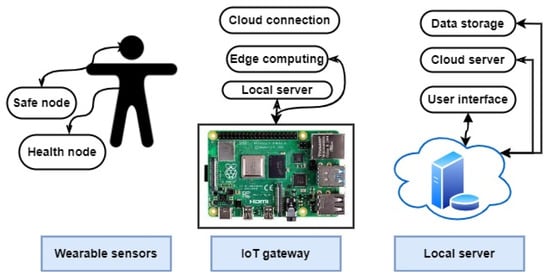
3.1. Use Cases of Health-Monitoring Sensors
Medical science research is currently dominated by medical healthcare, which mostly relies on how it integrates with the IoT. This integration is receiving a lot of attention due to its crucial role in utilizing technological paradigms to save human lives. These integrated systems contain three crucial phases, namely, the modules for data collection, data processing, and data evaluation. Healthcare monitoring plays a significant role in the data collection module due to its active involvement in gathering data from various sources and specimens. Most healthcare-monitoring systems use sensors to obtain the necessary input data. The more concise and timely the data, the more accurate the results.
Sensors are employed for more than just data collection; they can also be used for various ongoing and post-monitoring tasks in IoT-based healthcare systems. Blood pressure, body temperature, pulse oximetry, and blood glucose are a few examples of heterogeneous wearable sensing devices developed to collect patients’ biomedical data [14][50] in the era of fast-growing IoT. The proper quality and development of these IoT-based healthcare-monitoring systems are directly related to reliable data from sensors or sensor networks, which necessitates using advanced signal-processing techniques, sensor data fusion, and data analytics. In medical science, sensors that measure heart rate, body temperature, and other things are used to find and diagnose diseases at the earliest stage.
It has been observed that health-monitoring sensors are utilized in various use cases of medical science for healthcare purposes, such as the monitoring of hemoglobin concentration, molecular diagnostics, clinical diagnosis of albumin-related diseases, heart-rate detection, blood-oxygen-saturation detection, respiratory-rate detection, anemia detection, Alzheimer’s disease, and many more.
There are many applications for wearable sensors. IoT-assisted wearables are widely used these days. The friendliness of such devices has created a boom in their application in all fields. With the healthcare field being no exception, the IoT’s exploits in healthcare are enormous. Various technologies are linked to existing technology that helps generate data for monitoring and analysis.
There is a lot of use cases for IoT-based sensors in real-time environments, which are mentioned below:
Use Cases/Applications
1. Heart-rate detection/Cardiac monitoring systems/Stroke-
Heart-rate detection/Cardiac monitoring systems/Stroke
- 2.
-
Body-temperature measuring
- 3.
-
Activity recognition
- 4.
-
Blood-glucose monitoring and hemoglobin concentration
5. Respiration-rate detection and monitoring
Some writers employed sophisticated sensors that keep track of breathing patterns. A bio-impedance sensor can be useful [15][24][25][51,60,61].- 6.
-
Sleep monitoring
- 7.
-
Alzheimer’s disease monitoring and Anemia detection
- 8.
-
Molecular diagnostics and Clinical diagnosis
- 9.
-
Blood-oxygen-saturation detection
3.2. Classification of Health-Monitoring Sensors
With advancements in wireless communications, medical sensor technology, and data-collection methods, it is now possible to remotely monitor a person’s health by putting wearable technology on them and analyzing the data collected. These sensors and wearable devices can be integrated into various accessories such as clothing, wristbands, glasses, socks, hats, and shoes, as well as other devices such as smartphones, headphones, and wristwatches. Pawan Singh [39][75] classified medical sensors into two categories: contact sensors (i.e., on-body or wearables) and non-contact sensors (i.e., peripherals). Contact sensors are further classified into two sub-categories: monitoring and therapeutic. Again, non-contact sensors are further classified into three sub-categories. All the sub-categories are further classified based on their use. Figure 45 illustrates the classification of health-monitoring sensors with examples of their use.Primarily, health-monitoring sensors can be divided into contact (i.e., on-body) and non-contact (i.e., peripheral) sensors. Contact sensors are attached to the body to monitor physiological behaviors, chemical-level identification, and optical measurement-related monitoring. Contact sensors are also used in therapy-related monitoring such as medication, stimulation, and emergencies. Non-contact sensors are used for monitoring fitness- and wellness-related factors, behavior, and rehabilitation. An example of each type of monitoring is shown in Figure 45. The following are some of the medical applications that could benefit from the use of medical sensors and wearable devices [40][76]: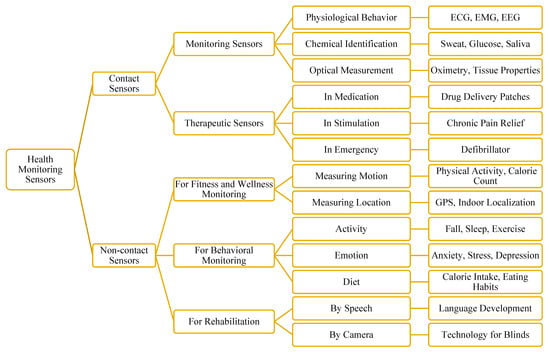
- Monitoring vital signs in hospitals.
- Aging in place and in motion.
- Assistance with motor and sensory impairments.
- Large-scale medical and behavioral research in the field.
- Monitoring vital signs in hospitals.
-
Aging in place and in motion.
-
Assistance with motor and sensory impairments.
-
Large-scale medical and behavioral research in the field.
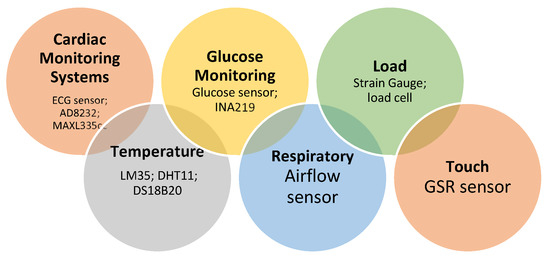
3.3. Performance Evaluation of IoT Sensors
Any healthcare-monitoring system’s sensors serve as its brain and heart. Thus, they must be reliable. Almost all types of sensors used should be small, quiet, accurate, have short data-transmission delays, use little power, and perform well overall. Wearable sensors must be both precise and compact, which presents a challenge. However, in case of wearable sensors, the more value is given to outputs, and they need to be reasonably accurate, too, so that the doctor can use these values to make decisions. Medical-grade sensors are large and difficult to transport and require specialized equipment and trained personnel [15][51]. Additionally, various IoT sensor-based applications constantly require authentication, security, and privacy. Numerous protocols are readily available on the market to assist with security and help offer some solutions over an extended period. Nevertheless, these integrated and crucial data-based apps’ security measures are constantly vulnerable to intrusion.

